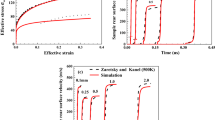Abstract
In this paper an optimal-control approach for thermal-stress reduction inside a Czochralski-grown single crystal is presented. Using the lateral heat flux as a control variable, an optimal-control formulation for minimizing thermal stress with a given crystal shape is derived. Since the thermal stress is also affected by the lateral shape of crystals during growth, the level of the stress can be reduced by growing crystals into a suitable shape. Using the lateral shape as a control variable, a similar optimal-control formulation for stress reduction is derived. In both cases, the von Mises stress is used as an objective function for the constrained optimization problem. Euler–Lagrange equations are derived using the calculus of variations and Lagrange multipliers. Various stress-reduction strategies are explored by solving the Euler–Lagrange equations numerically.
Similar content being viewed by others
References
Bornside DE, Kinney TA, Brown RA (1991) Minimization of thermoelastic stress in Czochralski grown silicon: application of the integrated system model. J Cryst Growth 108:779–805
Jordan AS, Caruso R, von Neida AR (1980) A thermoelastic analysis of dislocation generation in pulled GaAs crystals. The Bell Syst Tech J 59(4):593–637
Müller G (2002) Experimental analysis and modeling of melt growth processes. J Cryst Growth 237–239:1628–1637
Jeong JH, Kang IS (2002) Optimization of the crystal surface temperature distribution in the single-crystal growth process by the Czochralski method. J Comput Phys 177:284–312
Bohun S, Frigaard I, Huang H, Liang S (2006) A semi-analytical thermal stress model for the Czochralski growth of type III-V compounds. SIAM J Appl Math 66(5):1533–1562
Micklethwaite WF, Johnson AJ (2001) InSb: materials and devices. In: Capper P, Elliot CT (ed) Infrared detectors and emitters: materials and devices, chapter 7. Kluwer Academic Publishers, 177–204
Micklethwaite WF (2003) Firebird Semiconductors Ltd., Private communications
Armaou A, Christofides PD (2001) Crystal temperature control in the Czochralski crystal growth process. AICHE J 47(1):79–106
Margulies M, Witomski P, Duffar T (2004) Optimization of the bridgman crystal growth process. J Cryst Growth 266:175–181
Metzger M, Backofen R (2000) Optimal temperature profiles for annealing of GaAs-crystal. J Cryst Growth 220:6–15
Kuiken HK (1979) The cooling of low-heat-resistance cylinders by radiation. J Engng Math 13:97–106
Kuiken HK, Roksnoer PJ (1979) Analysis of the temperature distribution in FZ silicon crystals. J Cryst Growth 47(1):29–42
Brattkus K, Davis SH (1988) Directional solidification with heat losses. J Cryst Growth 91(4):538–556
Young GW, Heminger JA (1997) Modeling the time-dependent growth of single-crystal fibers. J Cryst Growth 178(3): 410–421
Young GW, Heminger JA (2000) A mathematical model of the edge-defined film-fed growth proccess. J Engng Math 38:371–390
Tatarchenko VA (1993) Shaped crystal growth. Kluwer, Academic Publishers
Ivanov NG, Korsakov AB, Smirnov EM, Khodosevitch KV, Kalaev VV, Makarov YuN, Dornberger E, Virbulis J, von Ammon W (2003) Analysis of magnetic field effect on 3D melt flow in CZ Si growth. J Cryst Growth 250:183–188
Hurle DTJ (1995) A mechanism for twin formation during Czochralski and encapsulated vertical bridgman growth of III-V compound semiconductors. J Cryst Growth 147:239–250
Liang S (2005) Thermal stress reduction inside InSb crystal grown by Czochralski method. Ph.D. Dissertation, York University
Hurle DTJ, Rudolph P (2004) A brief history of defect formation, segregation, faceting, and twinning in melt-grown semiconductors. J Cryst Growth 264:550–564
Author information
Authors and Affiliations
Corresponding author
Rights and permissions
About this article
Cite this article
Huang, H., Liang, S. Thermal-stress reduction for a Czochralski grown single crystal. J Eng Math 59, 1–23 (2007). https://doi.org/10.1007/s10665-006-9117-3
Received:
Accepted:
Published:
Issue Date:
DOI: https://doi.org/10.1007/s10665-006-9117-3



